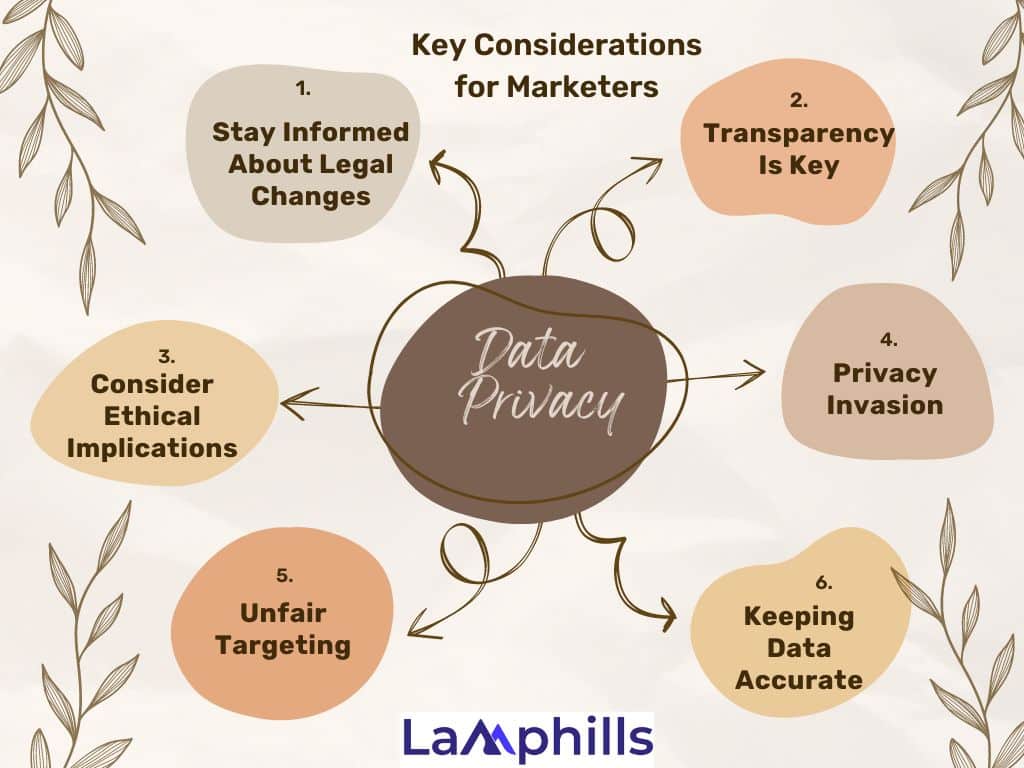Data privacy is a necessity in marketing. As a marketer, you collect information when customers interact with your brand. With so much online now, more data is available than ever. Focusing on customer data privacy and including it in your marketing strategy can build trust with your audience and keep you following the rules.
It is crucial to make customer data privacy a main part of your marketing strategy. At Lamphills, we understand that data privacy can be complicated and that you might have concerns. We created this article to explain the key points and best practices you should follow. By following these practices, you’ll gain your customers’ trust and comply with regulations. Let’s get started.
Key Points
- Data privacy means protecting and using people’s personal information, preferences, and activities in a fair and transparent way.
- In digital marketing, data privacy means keeping people’s personal information safe when companies collect it for marketing.
- Ethical data collection practices include using consent management tools, creating a preference center, using double opt-in, offering different communication methods, and explaining the benefits of data sharing to customers.
- Trust is critical for successful marketing.
- Marketers must stay informed about legal changes, prioritize transparency, consider the ethical implications of data use, avoid privacy invasion and unfair targeting, and ensure data accuracy.
What is Data Privacy?
When I started in digital marketing years ago, things were very different. Back then, not many people talked about data privacy; it was a new idea that wasn’t very clear to most people. As I worked on different marketing campaigns, I saw how people became more aware of their data rights and how laws changed. This experience taught me how important it is to keep people’s information safe to gain their trust and run a successful marketing strategy.
In simple terms, data privacy means protecting and using people’s personal information, preferences, and activities in a fair and transparent way. It involves rules and practices to keep personal information safe. It ensures people can control their data and decide how it is used and shared.
Today, many online services collect personal information. Protecting this information is very important. Good data privacy rules build trust and help comply with laws like GDPR and CCPA. They also prevent data breaches that can cause serious financial and reputation problems.
In digital marketing, data privacy means keeping people’s personal information safe when companies collect it for marketing. This information can include names, email addresses, phone numbers, location data, and browsing history.
Data privacy rules are meant to protect this information, making sure it stays private, accurate, and available when needed. They also ensure that companies are clear about how they collect, use, and store this information.
How Governments and Organizations Are Protecting Customer Data Privacy
Governments and organizations worldwide are working to protect personal information and address data collection concerns. As a marketer, following these rules when collecting data is important. Keep an eye on these regulations:
General Data Protection Regulation (GDPR)
The GDPR has significantly impacted marketing. This regulation gives people more control over their personal data and requires businesses to get clear permission before collecting and using it. As a result, marketers have had to change how they collect data and update their privacy policies.
One major challenge with GDPR is being transparent about data collection and use. Companies must inform people about their data practices and give them the choice to consent. This makes it harder for marketers to target customers and personalize content without proper permission.
Another important aspect of GDPR is handling requests for data access or deletion. Customers can ask companies to show or delete their data. Marketers must be ready to handle these requests quickly to comply with GDPR.
Imagine you run an online store. With GDPR, you need to tell customers exactly what personal information you collect, like their email and address, and ask if it’s okay to use it. For example, when someone signs up for your newsletter, you must clearly explain how you’ll use their email and get their permission. If a customer later asks you to show what data you have on them or wants you to delete it, you must do so quickly to follow the rules. This means you can’t send them personalized offers without their clear approval.
New Privacy Laws in the US
As data privacy rules change worldwide, the US is creating its own privacy laws. While there isn’t a nationwide regulation like the GDPR, individual states are stepping up to protect privacy.
For example, the California Consumer Privacy Act (CCPA), effective January 2020, gives Californians more control over their personal information. They can know what data is collected and who it’s shared with and request its deletion. The CCPA also allows consumers to opt out of selling personal information to third parties.
Another example of state-level privacy laws in the US is New York’s SHIELD Act, which stands for Stop Hacks and Improve Electronic Data Security. This law, which came into effect in March 2020, requires businesses to adopt safeguards to protect the private information of New York residents.
The SHIELD Act mandates that businesses have a data security program in place, including employee training, risk assessments, and proper disposal of private information. It also requires businesses to notify affected individuals quickly in the event of a data breach. The law covers a wide range of personal information, such as social security numbers, driver’s license numbers, and financial account information. The SHIELD Act aims to enhance data security and protect individuals’ private information from unauthorized access and breaches.
Other states are following California’s lead, such as the Colorado Privacy Act (CPA), passed in July 2021. This law gives people in Colorado similar rights to those in California and Virginia. They can find out what data companies have about them, ask for it to be deleted, and opt out of data collection. The CPA also requires businesses to be transparent about how they use personal information, making it easier for people to understand and control their data.
Apple’s Privacy-Focused Updates
Marketers are facing new challenges due to Apple’s privacy updates. One example is the Mail Privacy Protection (MPP) feature introduced in 2021. MPP uses a bot to open emails as soon as they arrive in the inbox. This protects user privacy by hiding IP addresses and preventing tracking of the recipient’s location or online activity.
In addition to MPP, Apple’s iOS 17 privacy updates add more protection for users. These updates make it harder for marketers to track and measure engagement in traditional ways. For instance, iOS 17 includes Link Tracking Protection, which automatically removes tracking details from messages, mail, and links, making it difficult to link interactions to specific users.
Despite these challenges, you don’t need to worry too much. Link tracking is still useful, with only specific link types being affected. It’s like putting a tiny label on a link in an email. When someone clicks on the link, you can see that they clicked it. For example, if you send an email with a link to a new blog post and someone clicks on that link, you can see that they clicked and know they were interested in the blog post. This helps you understand what your audience likes and how they interact with your content.
Best Practices for Responsible Data Collection
Data privacy isn’t just about following laws; it’s about respecting the people you market to and keeping their information safe like your own.
One time, early in my career, I was part of a very aggressive email campaign for a local café. It ended up upsetting our customers, who felt their data was misused. This taught me how critical it is to be clear and get permission from people before using their information and they are now key parts of how I approach marketing.
When collecting data, customers may feel hesitant about sharing their data. If they don’t agree to data collection, their experience might be less enjoyable. However, you can build a trusting relationship by being open and honest about what data you want and why you need it. Here are some ways to be ethical when collecting or using personal data:
#1 Use consent management tools
Don’t keep your customers in the dark about the data you collect. Use our consent insight feature when they sign up. This way, you can clearly explain what data you collect and how it will be used and give customers a simple choice to agree or not.
#2. Create a preference center
Show your customers you respect their choices by providing an easy-to-use preference center. Allow them to easily add or remove their information, and include a link to it in every email you send.
#3. Use double opt-in
Double opt-in ensures that your marketing lists are accurate and high-quality. Make this a standard for any channel you use, and your customer engagement will improve.
#4. Offer different ways to communicate
Different customers like different ways to stay in touch. Some prefer emails, while others like SMS or WhatsApp. To give them the best experience, let them choose their favorite way to hear from you.
#5. Explain the benefits
Help your customers see how sharing their data can make their experience with your brand better. Are you offering special deals? Personalizing content to their interests? Let them know what’s in it for them, and they’ll be more willing to share their data. Being clear and honest is very important.
As a marketer, you must handle personal information carefully and follow the laws that protect it. Below is a checklist to guide you through the essential steps to ensure your data privacy practices are up to standard.
By following this checklist, you can ensure your marketing practices are safe and respectful of customer data. Protecting personal information isn’t just about following the law; it’s about showing your customers that you value their trust.
How to Build Trust and Transparency
Trust is essential for a good marketer. It’s not just something extra; it’s essential. Customers know more than ever about the risks of sharing personal information online. By building trust with your customers, you can assure them that their data is safe with you. This helps create a good reputation for your company and makes customers feel secure when interacting with you.
Here are some ways to build trust and transparency:
#1. Seek Explicit Consent
Always get clear permission before collecting any personal data. Make sure the form where you ask for permission is easy to understand and straightforward. For example, use a simple checkbox explaining what people agree to.
#2. Privacy by Design
Include privacy in your marketing campaigns and technology designs from the start. Make data protection a priority from the beginning of any project.
Also, people’s rights to their data, such as the ability to see, change, delete, and move their data, should be respected. Make it easy for customers to use these rights.
#3. Limit Data Collection
Only gather the data you need. In the past, I collected too much data, thinking it might be helpful later. This not only made managing the data harder but also increased the risk of losing it. From this, I learned only to collect necessary data.
Collect only the data you need and avoid keeping extra information. This reduces risks and shows respect for your customers’ privacy.
You should also make it easy for customers to access and download their data. This will keep things transparent and give people control over their information.
#4. Collect Zero, First-Party and Third Party Data
Build trust by collecting zero-party customer data through surveys or sign-up forms. Also, gather first-party data from their actions, like visiting your website or engaging on social media.
Be careful when sharing third-party data. Make sure the company follows privacy laws and ethical guidelines and checks it thoroughly before sharing any data.
Note: Whenever you can, use data that doesn’t reveal people’s identities for marketing. This helps protect their privacy and lowers the risk of exposing personal information.
#5. Implement Robust Security Measures
Ensure all the data you collect is protected with strong security measures. I once dealt with a minor data breach, which made it clear we needed to improve our security. Since then, I have ensured all the marketing tools and platforms have the best security possible.
Protect customer information using encryption, secure storage systems, two-factor authentication, and safe data transfer methods. This helps prevent data breaches.
#6. Educate Your Team
Your marketing team must understand how to handle personal information safely. At Lamphills, we often hold training sessions to teach them about real-life examples and what can go wrong if data is mishandled.
Train your team on data privacy rules and best practices through workshops or training sessions so they know how to protect customer information.
#7. Incident Response Plan
Create a firm plan for handling data breaches or privacy issues. Act quickly, inform those affected and fix the problem.
You can appoint a Data Protection Officer (DPO) to ensure your company follows data privacy rules and makes contact with official authorities.
#8. Regularly Check Your Practices
As laws and technology change, update your privacy policies and make them easy for people to find and understand. Keeping our policies updated and letting our customers know about changes has helped them trust us more.
Review how your company handles data privacy regularly. Identify and fix any weak spots to keep your practices up-to-date and effective.
#9. Data Retention Policies
Set clear rules for how long you keep data. Delete any data you don’t need for marketing, and let customers know about this in your privacy policies.
#10. Cookie Consent
If you use cookies to track users, explain what they are and get their permission. Then, allow them to manage and turn off cookies if they want.
Key Considerations for Marketers
Whether you know it or not, your data is being collected constantly. Problems like breaking the rules, brands misusing data, and buying and selling customer data have created ethical problems for marketers.

To handle these ethical challenges responsibly, consider these key points when collecting and using customer data. This will help you make better decisions and keep your customer’s trust:
#1. Stay Informed About Legal Changes
Data privacy laws, such as GDPR in Europe and CCPA in California, affect people worldwide. It is crucial to keep up with these laws and change your marketing to fit them. For instance, when GDPR came out, I had to change many of our campaigns for our European audience to ensure we followed the new rules.
#2. Transparency Is Key
Always be transparent with your audience about collecting, using, and keeping their data. Being open helps build trust and can make people more loyal to your brand. Being transparent has made more people engage with our campaigns.
#3. Consider Ethical Implications
Think about the ethical side of data use. Ask yourself if you treat other people’s data the way you’d want your data treated. This approach has helped me make decisions that keep our brand image positive.
You must protect your customers’ data. Data breaches can cause financial losses and harm your customers and your business’s reputation.
Note: If you use AI or robots in your marketing, make sure they don’t harm data privacy. Be clear about how these automated systems make decisions.
#4. Privacy Invasion
Taking personal or sensitive information without your customers’ permission is wrong. This can make them worry about their privacy and get your brand in legal trouble.
Also, using customer data without permission is wrong. Don’t send emails, text messages, or call customers without their permission. This invades their privacy and can break privacy laws.
#5. Unfair Targeting
Avoid using personal information like gender, race, or disability to exclude certain groups. This can lead to discrimination and unfair treatment.
Again, don’t use customer data without their consent. This is unethical and can destroy customer trust. Make sure any third parties you work with handle data appropriately.
#6. Keeping Data Accurate
Finally, always double-check and update customer data to ensure it’s correct and current. Using incorrect information can lead to a bad customer experience.
By following these guidelines, you will not only reduce the risk when collecting data but also make your customers feel valued and respected.
Final Thoughts
Dealing with data privacy in marketing can be complicated, but using suitable methods and thinking about these issues carefully can make your marketing more respectful and practical.
When your audience sees that their privacy is important to you, it builds a strong foundation of trust. This trust leads to more meaningful and lasting relationships. As a result, your marketing efforts will succeed, as customers will reward you with their loyalty, positive word-of-mouth, and appreciation for your brand’s commitment to ethical practices.
By being careful and thoughtful about data privacy, marketers can comply with the law and build deeper trust with their audience, leading to better and longer-lasting marketing efforts.
Frequently Asked Questions
What are the 4 Key Points of Data Privacy?
The four key points of adoption, practice, system, and review are essential for ensuring data privacy in any business. These points help comply with regulations like India’s Digital Personal Data Protection Act, 2023.
What is the key concept of data privacy?
Data privacy is about keeping personal information safe and secure. It means keeping data private, protecting it from theft, only collecting and using it as needed, clearly explaining how data is used, and following the correct laws. Organizations should use the best security methods to protect sensitive data.
What is GDPR compliance for marketers?
GDPR means that you need permission to send marketing emails. But if you have a good reason to send the email, you don’t need permission (unless the person has asked not to get your emails). If you don’t have a good reason, you need their permission.
What are the four ways to protect customer data and privacy?
We’ve already discussed four main methods to keep your files safe: backups, encryption, masking, and confirmed erasure. Also, think about using tools to manage USB devices to secure all data stored on them.
What are the 5 main ideas of privacy?
The five main ideas of privacy are:
1. Appoint a person to oversee data protection.
2. Check how privacy is affected by different activities.
3. Set up a plan to manage privacy.
4. Put measures in place to keep data private and secure.
5. Regularly practice how to report any data breaches.
What data do marketers use?
Marketers use customer data, which is information about their customers. This includes details like their age, where they live, and what they are interested in. There are different ways to collect this information. One way is by tracking the types of people who visit your website.
Similar Articles
What is a DM? Scale Your Digital Marketing Strategies With Effective DMs
Level Up Your Marketing Strategy With Hyper-personalization
Top Careers in Digital Marketing: Roles and Responsibilities in 2024






